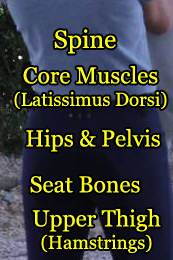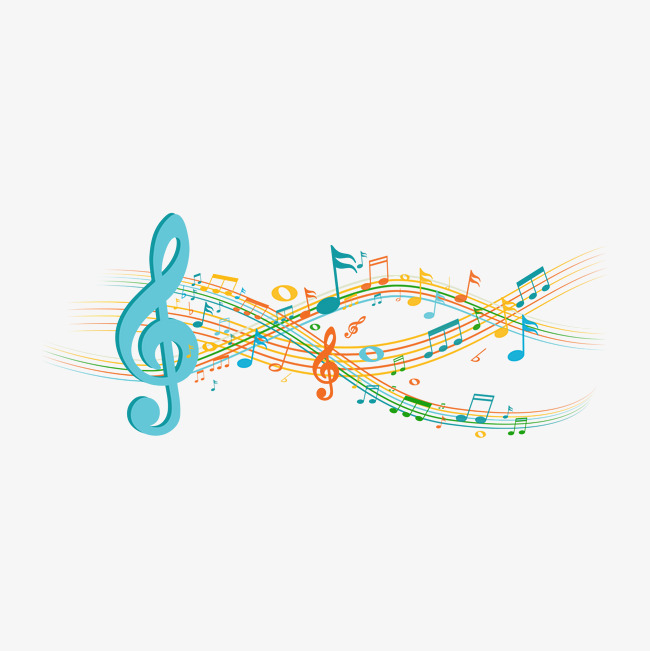
Rhythm – Let’s Get into the Groove Newsletter
What is Rhythm?
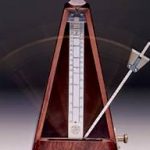 When reading tests and listening to people talk about dressage and the way horses move, it is easy to confuse rhythm and tempo. In general, rhythm relates to the horse’s way of going. It is how the horse moves and how he carries his rider. It is the distinct beats that each gait possesses.
When reading tests and listening to people talk about dressage and the way horses move, it is easy to confuse rhythm and tempo. In general, rhythm relates to the horse’s way of going. It is how the horse moves and how he carries his rider. It is the distinct beats that each gait possesses.
Rhythm is NOT the horse’s tempo. The horse’s tempo is how fast or slow the horse moves. It is the beat that the horse marches to or his internal metronome. The tempo can also be modified as needed by the rider’s aids and horse’s can be taught to go and be comfortable in a new tempo if they are given the appropriate support by the rider.
The Gaits and Their Beats
 Each gait has its own specific rhythm and tempo that distinguish it from the other gaits. I know that is a simplistic view, but it is definitely worth investigating further. When you watch a musical freestyle, those that catch your eye are often the ones that look like the horse is actually “dancing” in time to the music. There’s a reason for that appearance – the routine and music have been choreographed to match the tempo of the actual footfalls (rhythm) in each gait, but how?
Each gait has its own specific rhythm and tempo that distinguish it from the other gaits. I know that is a simplistic view, but it is definitely worth investigating further. When you watch a musical freestyle, those that catch your eye are often the ones that look like the horse is actually “dancing” in time to the music. There’s a reason for that appearance – the routine and music have been choreographed to match the tempo of the actual footfalls (rhythm) in each gait, but how?
Well, let’s break out the metronome and see how this rhythm and tempo thing works.
In the Walk
The walk has a rhythm of four footfalls that average a tempo of about 50-65 bpm (or beats per minute). If you were to watch a video of most horses walking they would be able to march in time to songs like “Carry On” by FUN (50 bpm), “Honkey Cat” by Elton John (58 bpm), The Lion Sleeps Tonight by The Tokens (61 bpm), “Chopin: Nocturne in E flat Major Op.9 No.2” (61 bpm) & “One for My Baby” by Jan Johannson (65 bpm).
In the Trot
In the trot, the horse has 2 distinct beats of the diagonal pairs at a rate of 75-90 bpm. So let’s pick up the pace a little. Songs like Elvis Presley’s “All Shook Up” (75 bpm), Shania Twain’s “Come On Over” (75 bpm), “In the Mood” by The Glenn Miller Band (85 bpm), “Hungarian Rhapsody” done by the Royal Danish Symphony Orchestra & Wilhelm Ruggeberg (87 bpm), “The Cello” by the Piano Guys (85 bpm), “Sonata in A Minor, K. 59” as played by Vladimir Horowitz (88 bpm) and “Hit the Road Jack” by the Mo’ Horizons (90 bpm) will show your horse’s style.
In the Canter
Let the fun begin. The canter is a 3 beat gait that has a moment of suspension with footfalls ranging from 95-110 bpm. You can hit the sand dance floor with songs like Ed Sheeran’s “Perfect” (95 bpm), Pentatonix’s “Can’t Sleep Love” (95 bpm), “Another One Bites the Dust” by Queen (100 bpm) (but please don’t take this one literally), “Justin Timberlake’s “Rock Your Body” (101 BPM), The Beatles “All You Need is Love” (103 bpm), “The Best” by Tina Turner (104 bpm), Dexy’s Midnight Runner “Come on Eileen” (109 bpm) & “Suite No. 3 in D Major” by Johann Sebastian Bach (110 bpm). Who wouldn’t have fun showing off their moves to these great songs?
Ok, let’s get back to the more serious side of rhythm. Let’s take a look at how the judges see rhythm.
Rhythm from the Judges Perspective
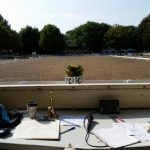 When the judge looks at our horse in motion, there are specific characteristics that must be present. The one that most dressage riders are familiar with is “Forward.” Forward obviously is not just about the direction of travel. Rather forward is a state of mind. The horse that is moving forward is carrying his rider with purpose, carrying himself well and is responsive to the rider’s requests. In addition to “forward,” the gaits must be pure. Purity pertains to the beats and timing of the gaits. Each gait must be correct in the number of beats and the timing of those beats, which relates to the information provided above. And finally, the horse must be sound. You may have heard of someone being disqualified from their test because their horse was not “sound.” If this has happened, it was because the horse did not exhibit eveness in the steps. This does not relate to tempo, but rather the horse’s ability to bear weight evenly and provide a levelness to his steps. Now, that we have an idea of what the judges look for in regards to the gaits in general, let’s breakdown some of the characteristics that should be present in each of the gaits as well.
When the judge looks at our horse in motion, there are specific characteristics that must be present. The one that most dressage riders are familiar with is “Forward.” Forward obviously is not just about the direction of travel. Rather forward is a state of mind. The horse that is moving forward is carrying his rider with purpose, carrying himself well and is responsive to the rider’s requests. In addition to “forward,” the gaits must be pure. Purity pertains to the beats and timing of the gaits. Each gait must be correct in the number of beats and the timing of those beats, which relates to the information provided above. And finally, the horse must be sound. You may have heard of someone being disqualified from their test because their horse was not “sound.” If this has happened, it was because the horse did not exhibit eveness in the steps. This does not relate to tempo, but rather the horse’s ability to bear weight evenly and provide a levelness to his steps. Now, that we have an idea of what the judges look for in regards to the gaits in general, let’s breakdown some of the characteristics that should be present in each of the gaits as well.
In the walk, the horse should look as though they are marching with even and precise steps. They should not be lollygagging or out for a Sunday stroll. The steps should be ground covering with the hind foot stepping in front of the front hoof prints.
The trot should be ground covering where the hind hooves track into the hoofprints of the front hooves. The horse’s legs should travel in diagonal pairs – inside hind and outside front & outside hind and inside front. There is a distinct moment of suspension after each diagonal pair leaves the ground.
The canter should have an uphill tendency with the horse stepping underneath his center of gravity. In this gait, the horse should start with outside hind, followed by the diagonal pair – inside hind and outside front, then the inside front strikes the ground followed by a moment of suspension – often referred to as the jump in the canter.
Rhythm Faults and Their Causes
The greatest faults in rhythm, that are not due to soundness issues, are almost always a result of too much hand being used. In order to correct this, we must have more seat and legs to drive the horse more forward. Forward allows the aids to come through and thus helps the horse to maintain a more consistent rhythm in his gaits.
As we discussed in the previous webinar, the seat is the single most important aid that we have. Because it is in direct communication with the horse’s back, the seat has a profound impact on the horse’s rhythm. If the seat is not well-balanced, independent and relaxed, as we have discussed previously, the horse cannot be well-balanced and relaxed. Lack of a good seat can cause a break in the connection with the horse which ultimately interferes with the horse’s movement.
Some of the most common faults seen are:
General Faults
The horse speeds up and slows down within the gaits and is a form of gait irregularity. Gait irregularity also refers to the length of the strides. The gait is said to be irregular if the strides are not equal among the legs. Another common fault is that the horse is not moving with purpose or is “lazy” – generally meaning that the horse lacks impulsion. And finally, the horse is rushing. When a horse is rushing often times the horse has fallen onto the forehand.
Unless there is a lameness/soundness issue, most rhythm faults are associated with an error in the rider’s aids – usually the rein aids.
In the Walk
The walk is lateral/pacing – In a lateral or pacing walk, the feet on the same side of the horse leave at the same time. This is similar to what you will see in many gaited horses when they are gaiting. The cause is almost always caused by the hand blocking the horse’s forward movement.
Irregular footfalls – This is where the horse takes a shorter step with one of the legs. It give a feeling of a long stride and then a short one. Generally caused by the rider blocking the horse on one side or the other with his rein aids. The rider should focus on the connection to be sure that there is equal contact on both sides.
Jigging – the horse starts to do short choppy steps and then breaks into a really short-strided trot/jog. Keeping the horse attentive to the half halts and aids will help to eliminate any jigging. It is imperative that the rider correct any tension in the horse before it escalates into jigging. Sometimes a horse that is quick to anticipate the transition will jig. Be sure to half halt before giving any aids to help give the horse a heads up that something is going to happen.
In the Trot
Rushing – this can be the cause of the horse falling on the forehand. A horse that is rushing feels almost as if you are running down a hill. The farther down the hill you travel, the harder it is to keep your feet underneath you. The same is true for the horse. If he continues to be driven forward with the seat and leg and is not supported by the connection, the horse will inevitably fall onto the forehand to try to keep up with the energy that is being created from behind. Driving the horse too much with the seat and legs without providing adequate connection and half halts will force the horse onto the forehand. As a result, the horse must be re-balanced and collected with the half halt, so that he can come back into a rhythm that is appropriate for him.
On the forehand – the horse is rushing and has blown through the rider’s connection. The withers are lowered and the horse is no longer carrying himself. In order to correct this, the rider must create a solid connection and correct the horse with appropriately applied half halts to slow and rebalance the horse.
Laziness – the horse that is lazy seems to need continual driving from the seat and leg to maintain the energy. Unfortunately, continual nagging will only make the problem worse. The horse must be taught to go forward on his own. Drive the horse with the seat and legs and then leave him alone to do his work. When he waivers in his rhythm again, ask him again. But while he is working correctly, be sure not to nag him. Nagging only causes him to become more dependent on the driving aids until he cannot be left to go alone. Then, you end up exhausted because you have to work every step of the rider instead of each member of the partnership carrying their own weight.
In the Canter
4 Beat/Lateral – This canter tends to be more like a gallop than a canter. Each foot strikes the ground individually instead of outside hind, inside hind/outside front and inside front with a moment of suspension following. This is a balancing act between the aids. The horse must be driven forward into a steady contact.
No Jump – This canter actually lacks energy. The horse should clearly have a jump into the moment of suspension. Driving the horse with the seat and leg more forward into a steady contact will help to create the energy necessary to solidify the distinct rhythm and jump of the canter.
On the Forehand – As with the trot, the horse that canters on the forehand lacks self-carriage and is generally not being ridden into a steady contact. Work to steady the contact and the horse will be able to carry himself better.
As you can see, rhythm is closely related to the aids.
Developing the Horse’s Rhythm
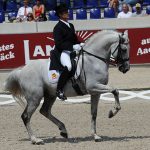 Now, that we understand what the rhythm is and some of the common faults, let’s look at how we can develop a consistent rhythm. Developing a consistent rhythm takes time because the horse has to develop the strength and suppleness necessary to maintain his balance. Once the horse is capable of maintaining his balance, he will be able to maintain his rhythm. Here are some basic exercises that will help to improve the horse’s rhythm.
Now, that we understand what the rhythm is and some of the common faults, let’s look at how we can develop a consistent rhythm. Developing a consistent rhythm takes time because the horse has to develop the strength and suppleness necessary to maintain his balance. Once the horse is capable of maintaining his balance, he will be able to maintain his rhythm. Here are some basic exercises that will help to improve the horse’s rhythm.
Half Halts
In addition to rebalancing the horse, the half halt is the key to communicating effectively with the horse. These are the indicator for the horse that something is going to change. A good half halt will create a better connection with the rider’s hand and encourage the horse to step underneath himself and carry more weight behind.
Transitions between the gaits
The majority of every dressage test score is made up on transitions. These essential elements require coordination of the aids and attentiveness by the horse. In upward transitions, the horse is alerted to the change with a half halt where the horse is asked to shift his weight to the hindquarter first and then the rider gives with the hand slightly to allow the horse to proceed into the next gait. The rider will also half halt the horse prior to the downward transition; however, the restraining aids are applied to indicate that the horse should transition. Whether upward or downward, the horse must remain on the contact and carrying himself. This balance and coordination of the aids will help the horse to improve his ability to maintain his rhythm.
Transitions within the gaits
Once the horse understands the aids for the transitions between the gaits, he can be introduced to transitions within the gaits. This is done by lengthening or collecting the stride. Transitions within the gaits are not related to the horse’s tempo, but rather the length and trajectory of the strides. Like the transitions between the gaits, the transitions within the gaits further the development of the horse’s carrying power, balance and coordination. All of these characteristics lead to more strength, more self-carriage and better rhythm.
While it is easy to become confused by the terms rhythm and tempo, it is imperative that the rider understand the difference between the two. Many refer to the horse’s rhythm when, in fact, they are talking about the tempo. Tempo is directly related to the speed at which the horse’s hooves touch the ground in any given gait. Rhythm, however, talks about the biomechanics and technical aspects of each gait. When watching the horse move, it is important to pay close attention to the purity and regularity of the horse’s rhythm. These two characteristics will have a profound impact on the individual movements and your overall score. More importantly, the rhythm is about the horse’s way of going. Rhythm faults are indicative of a training issue or possibly a soundness issue. Either of which must be addressed before continuing on. Correcting the horse’s rhythm requires the rider to become intimately aware of the horse’s movement in each gait and their own ability to coordinate the aids. Mastering this understanding will provide an excellent foundation for the rest of your dressage training and will yield a horse that carries himself in a consistent rhythm regardless of the gait.
Author: Dressage Academy
You May Also Like

Food for Thought
July 10, 2017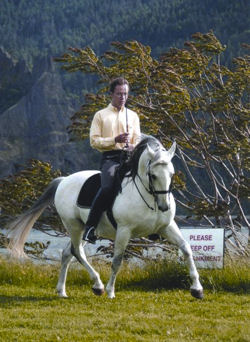
Rejuvenate Your Dressage Horse
July 6, 2017